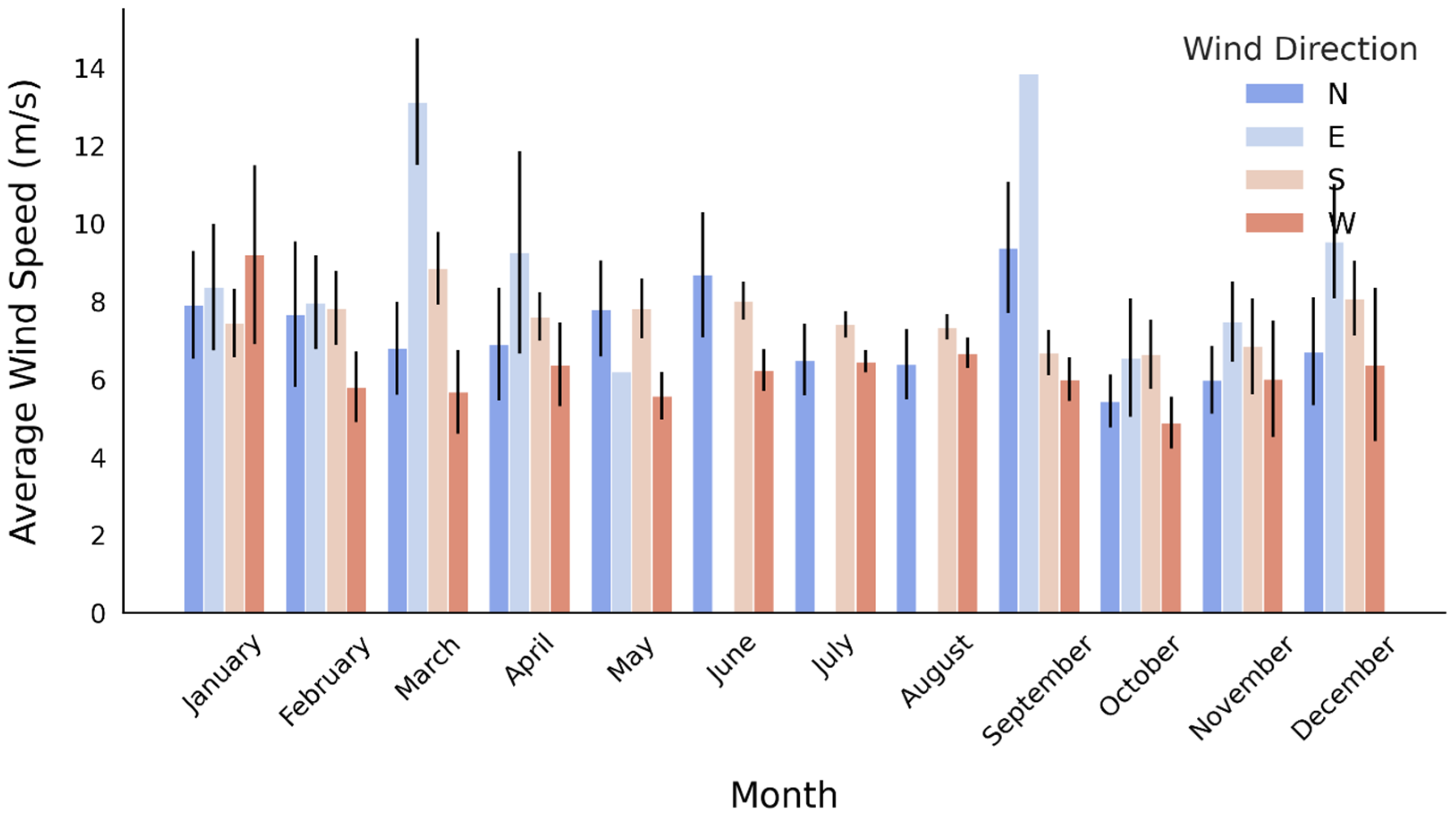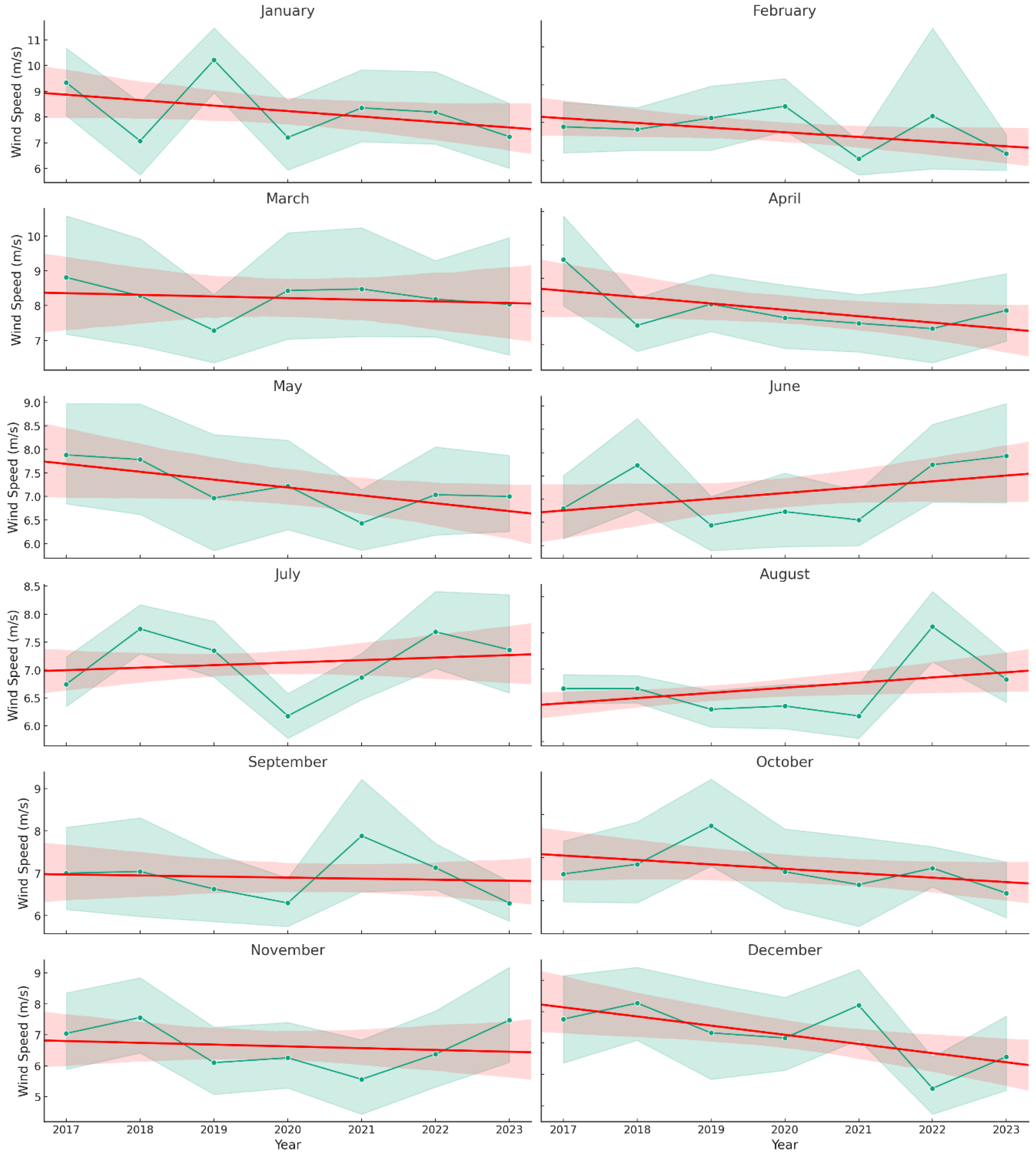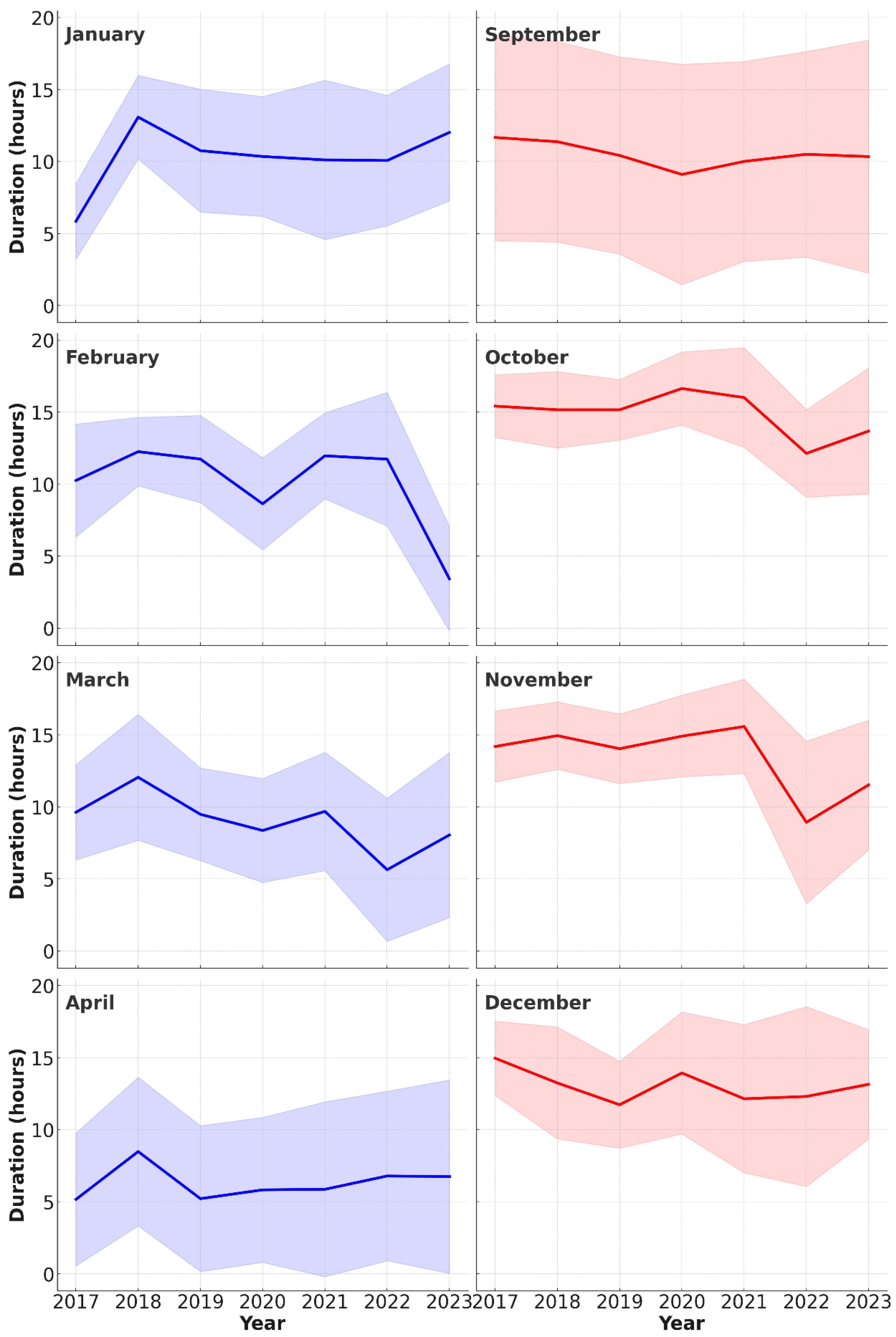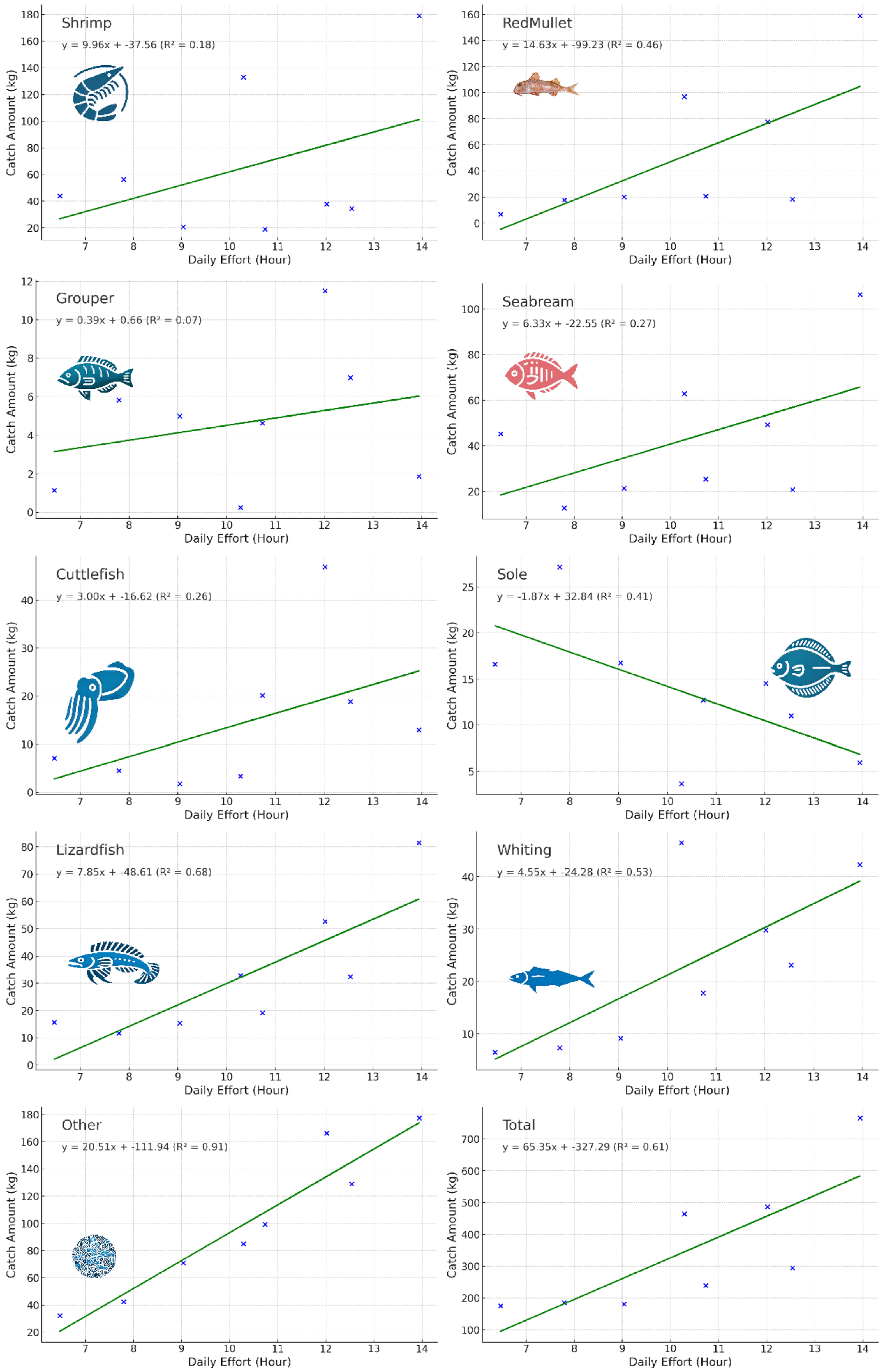Impact of Regional Wind Changes on Trawl Fishing Effort Under the Pressure of Overfishing in the Iskenderun Bay
Abstract
1. Introduction
2. Materials and Methods
3. Results
4. Discussion
5. Conclusions
Funding
Institutional Review Board Statement
Informed Consent Statement
Data Availability Statement
Acknowledgments
Conflicts of Interest
References
- Lleonart, J.; Maynou, F. Fish stock assessments in the Mediterranean: State of the art. Sci. Mar. 2003, 67 (Suppl. S1), 37–49. [Google Scholar] [CrossRef]
- Vasilakopoulos, P.; Maravelias, C.D.; Tserpes, G. The alarming decline of Mediterranean fish stocks. Curr. Biol. 2014, 24, 1643–1648. [Google Scholar] [CrossRef] [PubMed]
- Colloca, F.; Scarcella, G.; Libralato, S. Recent trends and impacts of fisheries exploitation on Mediterranean stocks and ecosystems. Front. Mar. Sci. 2017, 4, 244. [Google Scholar] [CrossRef]
- Froese, R.; Winker, H.; Coro, G.; Demirel, N.; Tsikliras, A.C.; Dimarchopoulou, D.; Scarcella, G.; Quaas, M.; Matz-Lück, N. Status and rebuilding of European fisheries. Mar. Pol. 2018, 93, 159–170. [Google Scholar] [CrossRef]
- Food and Agriculture Organization (FAO). The State of Mediterranean and Black Sea Fisheries 2020; General Fisheries Commission for the Mediterranean: Rome, Italy, 2020. [Google Scholar] [CrossRef]
- Demirci, S.; Demirci, A.; Şimşek, E. Spawning season and size at maturity of a migrated fish, Randall’s Threadfin Bream (Nemipterus randalli) in Iskenderun Bay, Northeastern Mediterranean, Turkey. Fresenius Environ. Bull. 2018, 27, 503–507. [Google Scholar]
- Şimşek, E.; Demirci, A.; Akar, Ö.; Demirci, S. Distortions in Eastern Mediterranean deep-sea fishery due to geopolitical instability and fishery pressures. In Proceedings of the 2nd International Congress on Engineering and Life Sciences, Kastamonu, Türkiye, 11–14 April 2019; pp. 670–672. [Google Scholar]
- Demirci, S.; Demirci, A.; Şimşek, E. The Validation of different growth models of Randall’s threadfin bream, Nemipterus randalli (Russell, 1986), in Northeastern Mediterranean Sea. Pak. J. Zool. 2020, 52, 1113–1119. [Google Scholar] [CrossRef]
- Demirhan, S.A.; Alkan, A.; Şimşek, E. Artificial reef application from the Iskenderun Bay, Northeastern Mediterranean, Turkey; an experimental study. Sak. Univ. J. Sci. 2020, 24, 49–54. [Google Scholar] [CrossRef]
- Demirci, S. The impact of the COVID-19 pandemic on the Iskenderun Bay fishery, Northeastern Mediterranean, Turkey. Thalassas 2024, 40, 43–49. [Google Scholar] [CrossRef]
- Demirci, S. Selectivity of Square and Diamond Mesh Trawl Codend for Some Fish Species in North East Mediterranean. Ph.D. Thesis, Mustafa Kemal University, Hatay, Türkiye, 2009. [Google Scholar]
- Özyurt, C.E.; Kiyağa, V.B. The commercial and discard catch rates of the trawl fishery in the Iskenderun Bay, Northeastern Levantine Sea. Trak. Univ. J. Nat. Sci. 2016, 17, 123–129. [Google Scholar] [CrossRef]
- Ok, M. Seasonal fishery bans and their effects on juvenile fish populations in the Mediterranean. Mediterr. Mar. Sci. 2012, 13, 251–258. [Google Scholar] [CrossRef]
- Free, C.M.; Mangin, T.; Molinos, J.G.; Ojea, E.; Burden, M.; Costello, C.; Gaines, S.D. Realistic fisheries management reforms could mitigate the impacts of climate change in most countries. PLoS ONE 2020, 15, e0224347. [Google Scholar] [CrossRef] [PubMed]
- Yaakob, O.; Quah, P.C. Weather downtime and its effect on fishing operation in Peninsular Malaysia. J. Teknol. 2005, 42, 13–26. [Google Scholar] [CrossRef]
- Cheung, W.W.; Pinnegar, J.; Merino, G.; Jones, M.C.; Barange, M. Review of climate change impacts on marine fisheries in the UK and Ireland. Aquat. Conserv. 2012, 22, 368–388. [Google Scholar] [CrossRef]
- Diouf, N.S.; Ouedraogo, I.; Zougmoré, R.B.; Niang, M. Fishers’ perceptions and attitudes toward weather and climate information services for climate change adaptation in Senegal. Sustainability 2020, 12, 9465. [Google Scholar] [CrossRef]
- Nagy, H.; Di Lorenzo, E.; El-Gindy, A. The impact of climate change on circulation patterns in the Eastern Mediterranean Sea upper layer using Med-ROMS model. Prog. Oceanogr. 2019, 175, 226–244. [Google Scholar] [CrossRef]
- Garcia-Soto, C.; Cheng, L.; Caesar, L.; Schmidtko, S.; Jewett, E.B.; Cheripka, A.; Rigor, I.; Caballero, A.; Chiba, S.; Báez, J.C.; et al. An overview of ocean climate change indicators: Sea surface temperature, ocean heat content, ocean pH, dissolved oxygen concentration, arctic sea ice extent, thickness and volume, sea level and strength of the AMOC (Atlantic Meridional Overturning Circulation). Front. Mar. Sci. 2021, 8, 642372. [Google Scholar] [CrossRef]
- Max Planck Institute for Chemistry. Overall Warming of up to 5 °C in This Century Projected for the Eastern Mediterranean and Middle East. ScienceDaily. 2022. Available online: https://www.sciencedaily.com/releases/2022/09/220906114225.htm (accessed on 6 February 2025).
- Zittis, G.; Almazroui, M.; Alpert, P.; Ciais, P.; Cramer, W.; Dahdal, Y.; Fnais, M.; Francis, D.; Hadjinicolaou, P.; Howari, F.; et al. Climate change and weather extremes in the Eastern Mediterranean and Middle East. Rev. Geophys. 2022, 60, e2021RG000762. [Google Scholar] [CrossRef]
- Mavruk, S.; Bengil, F.; Yeldan, H.; Manasirli, M.; Avsar, D. The trend of lessepsian fish populations with an emphasis on temperature variations in Iskenderun Bay, the Northeastern Mediterranean. Fish. Oceanogr. 2017, 26, 542–554. [Google Scholar] [CrossRef]
- Mavruk, S.; Saygu, İ.; Bengil, F.; Alan, V.; Azzurro, E. Grouper fishery in the Northeastern Mediterranean: An assessment based on interviews on resource users. Mar. Pol. 2018, 87, 141–148. [Google Scholar] [CrossRef]
- Aykut, F.; Tezcan, D. Evaluating Sea level rise impacts on the Southeastern Türkiye Coastline: A Coastal vulnerability perspective. PFG-J. Photogramm. Remote Sens. Geoinf. Sci. 2024, 92, 335–352. [Google Scholar] [CrossRef]
- Bengil, F.; Mavruk, S.; Polat, S.; Akbulut, G. An evaluation on the proximity of satellite- and model-based datasets of temperature and chlorophyll-a in coastal areas of İskenderun Bay. Ege J. Fish. Aquat. Sci. 2024, 41, 220–225. [Google Scholar] [CrossRef]
- Cutajar, K.; Gauci, A.; Falconer, L.; Massa-Gallucci, A.; Cox, R.E.; Beltri, M.E.; Bardócz, T.; Deidun, A.; Telfer, T. Wind and shipping influences on sea currents around an inshore fish farm in a heavily contested Mediterranean embayment. Reg. Stud. Mar. Sci. 2023, 62, 102855. [Google Scholar] [CrossRef]
- Farquhar, S.D.; Nirindrainy, A.F.; Heck, N.; Saldarriaga, M.G.; Xu, Y. The impacts of long-term changes in weather on small-scale fishers’ available fishing hours in Nosy Barren, Madagascar. Front. Mar. Sci. 2022, 9, 841048. [Google Scholar] [CrossRef]
- Menon, M.; Ghosh, S.; Kumar, M.S.; Rao, M.; Mahesh, V.; Zacharia, P.U. Fishermen’s perception of climate change-a study from Andhra Pradesh. Indian J. Fish. 2016, 61, 110–119. [Google Scholar] [CrossRef]
- Berg, C.W.; Wieland, K.; Rindorf, A. Effect of tow duration, door spread, and swept area on the catch efficiency of a bottom trawl. Fish. Res. 2024, 278, 107108. [Google Scholar] [CrossRef]
- Can, M.F.; Demirci, A. Effect of towing duration on the catch per unit of swept area (CPUE) for Lizardfish, Saurida undosquamis (Richardson, 1848), from the bottom trawl surveys in the Iskenderun Bay. Turk. J. Fish. Aquat. Sci. 2004, 4, 99–103. [Google Scholar]
- Can, M.F.; Mazlum, Y.; Demirci, A.; Aktaş, M. The catch composition and catch per unit of swept area (CPUE) of penaeid shrimps in the bottom trawls from Iskenderun Bay, Turkey. Turk. J. Fish. Aquat. Sci. 2004, 4, 87–91. [Google Scholar]
- Sangün, L.; Basusta, N.; Guney, O.I. Determination of catch composition in the bottom trawling using multivariate statistical methods in Eastern Mediterranean. Fresenius Environ. Bull. 2018, 27, 6317–6323. [Google Scholar]
- Dikou, A. Depletion fishing of the alien fish species Siganus luridus, S. rivulatus, Pterois miles, and Etrumeus golanii in the Mediterranean Sea-gear, ecosystem impacts, and resolution. Fish. Res. 2024, 278, 107095. [Google Scholar] [CrossRef]
- Can, M.F.; Mazlum, Y. Impacts of Global Warming on Sea Surface Temperature, pH, and Dissolved Oxygen in the Eastern (Mersin) and Western (Muğla) Mediterranean Regions of Turkey; Yaz Publications: Afyonkarahisar, Türkiye, 2024; pp. 138–165. [Google Scholar]



 : all shrimp species,
: all shrimp species,  : red mullet,
: red mullet,  : all grouper species,
: all grouper species,  : all cephalopods,
: all cephalopods,  : sole,
: sole,  : brushtooth lizardfish,
: brushtooth lizardfish,  : whiting,
: whiting,  : other caught species).
: other caught species).
 : all shrimp species,
: all shrimp species,  : red mullet,
: red mullet,  : all grouper species,
: all grouper species,  : all cephalopods,
: all cephalopods,  : sole,
: sole,  : brushtooth lizardfish,
: brushtooth lizardfish,  : whiting,
: whiting,  : other caught species).
: other caught species).
 : all shrimp species,
: all shrimp species,  : red mullet,
: red mullet,  : all grouper species,
: all grouper species,  : all cephalopods,
: all cephalopods,  : sole,
: sole,  : brushtooth lizardfish,
: brushtooth lizardfish,  : whiting,
: whiting,  : other caught species).
: other caught species).
 : all shrimp species,
: all shrimp species,  : red mullet,
: red mullet,  : all grouper species,
: all grouper species,  : all cephalopods,
: all cephalopods,  : sole,
: sole,  : brushtooth lizardfish,
: brushtooth lizardfish,  : whiting,
: whiting,  : other caught species).
: other caught species).
| Variable | Coefficient | p-Value | 95% CI Lower | 95% CI Upper |
|---|---|---|---|---|
| Intercept | 13.737 | 2.161 × 10−93 | 12.508 | 14.966 |
| C(Month)[T.2] | −0.788 | 9.197 × 10−2 | −1.704 | 0.129 |
| C(Month)[T.3] | −1.115 | 1.409 × 10−2 | −2.004 | −0.225 |
| C(Month)[T.4] | −4.045 | 3.438 × 10−17 | −4.975 | −3.114 |
| C(Month)[T.9] | −0.129 | 7.870 × 10−1 | −1.062 | 0.805 |
| C(Month)[T.10] | 3.838 | 3.994 × 10−17 | 2.953 | 4.723 |
| C(Month)[T.11] | 2.577 | 9.000 × 10−9 | 1.702 | 3.451 |
| C(Month)[T.12] | 2.500 | 1.816 × 10−8 | 1.633 | 3.366 |
| C(Year)[T.2018] | 1.457 | 4.637 × 10−4 | 0.642 | 2.272 |
| C(Year)[T.2019] | 0.032 | 9.392 × 10−1 | −0.784 | 0.848 |
| C(Year)[T.2020] | 0.044 | 9.175 × 10−1 | −0.781 | 0.868 |
| C(Year)[T.2021] | 0.235 | 5.740 × 10−1 | −0.584 | 1.053 |
| C(Year)[T.2022] | −2.039 | 2.881 × 10−5 | −2.992 | −1.086 |
| C(Year)[T.2023] | −1.346 | 5.076 × 10−3 | −2.287 | −0.405 |
| C(Direction)[T.ENE] | 0.115 | 8.711 × 10−1 | −1.270 | 1.499 |
| C(Direction)[T.ESE] | −0.635 | 1.959 × 10−1 | −1.599 | 0.328 |
| C(Direction)[T.N] | 0.441 | 4.287 × 10−1 | −0.652 | 1.535 |
| C(Direction)[T.NE] | −0.619 | 4.505 × 10−1 | −2.229 | 0.990 |
| C(Direction)[T.NNE] | −1.138 | 1.860 × 10−1 | −2.824 | 0.549 |
| C(Direction)[T.NNW] | −0.106 | 8.258 × 10−1 | −1.048 | 0.837 |
| C(Direction)[T.NW] | 0.247 | 7.140 × 10−1 | −1.073 | 1.566 |
| C(Direction)[T.S] | −0.713 | 4.921 × 10−1 | −2.748 | 1.322 |
| C(Direction)[T.SE] | 0.492 | 4.336 × 10−1 | −0.740 | 1.724 |
| C(Direction)[T.SSE] | 0.830 | 3.497 × 10−1 | −0.911 | 2.572 |
| C(Direction)[T.SSW] | −0.430 | 6.222 × 10−1 | −2.141 | 1.281 |
| C(Direction)[T.SW] | −0.907 | 2.220 × 10−1 | −2.363 | 0.549 |
| C(Direction)[T.W] | −0.974 | 5.451 × 10−2 | −1.968 | 0.019 |
| C(Direction)[T.WNW] | 1.120 | 2.688 × 10−1 | −0.866 | 3.106 |
| C(Direction)[T.WSW] | −0.627 | 2.054 × 10−1 | −1.599 | 0.344 |
| Wind Intensity | −0.367 | 1.882 × 10−26 | −0.434 | −0.301 |
Disclaimer/Publisher’s Note: The statements, opinions and data contained in all publications are solely those of the individual author(s) and contributor(s) and not of MDPI and/or the editor(s). MDPI and/or the editor(s) disclaim responsibility for any injury to people or property resulting from any ideas, methods, instructions or products referred to in the content. |
© 2025 by the author. Licensee MDPI, Basel, Switzerland. This article is an open access article distributed under the terms and conditions of the Creative Commons Attribution (CC BY) license (https://creativecommons.org/licenses/by/4.0/).
Share and Cite
Demirci, S. Impact of Regional Wind Changes on Trawl Fishing Effort Under the Pressure of Overfishing in the Iskenderun Bay. Sustainability 2025, 17, 2055. https://doi.org/10.3390/su17052055
Demirci S. Impact of Regional Wind Changes on Trawl Fishing Effort Under the Pressure of Overfishing in the Iskenderun Bay. Sustainability. 2025; 17(5):2055. https://doi.org/10.3390/su17052055
Chicago/Turabian StyleDemirci, Sevil. 2025. "Impact of Regional Wind Changes on Trawl Fishing Effort Under the Pressure of Overfishing in the Iskenderun Bay" Sustainability 17, no. 5: 2055. https://doi.org/10.3390/su17052055
APA StyleDemirci, S. (2025). Impact of Regional Wind Changes on Trawl Fishing Effort Under the Pressure of Overfishing in the Iskenderun Bay. Sustainability, 17(5), 2055. https://doi.org/10.3390/su17052055





